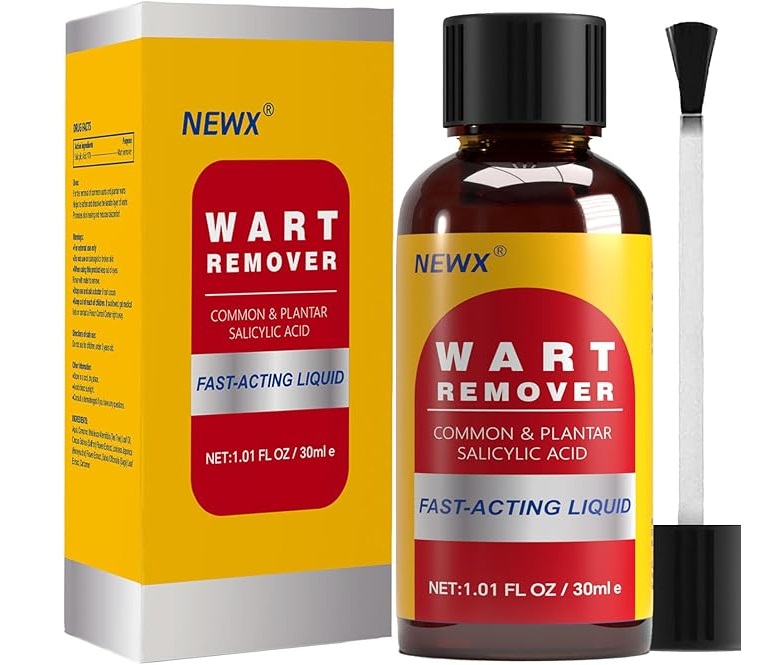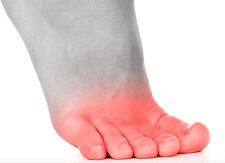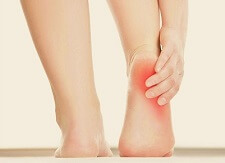- Home
- Common Foot Problems
- Plantar Warts
Plantar Warts
Written By: Chloe Wilson BSc(Hons) Physiotherapy
Reviewed By: FPE Medical Review Board
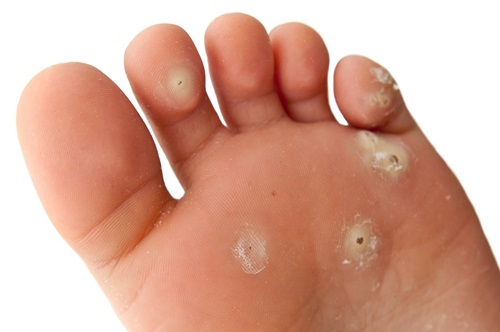
Plantar warts, commonly known as verrucas, are a type of skin infection that appear on the soles of the feet.
Although generally harmless, these growths can cause significant discomfort, particularly when walking or standing.
Plantar warts are caused by a virus and are highly contagious, spreading easily through direct or indirect contact. Most people will have at least one verruca at some point, but they are most common in children, teenagers and young adults.
While most verrucas will eventually go away on their own, it can take a couple of years, but the good news is there are some things that you can do to speed up the healing process.
In this article, we’ll explore what plantar warts on feet are, their causes, symptoms, treatment options, and what to expect during recovery.
What Is a Plantar Wart?
Plantar warts are small, rough, grainy growths on the skin’s surface. They typically develop on the weight-bearing areas of the feet, such as the heel or ball of the foot, or in between toes.
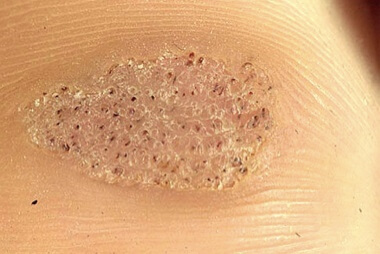
The hallmark feature of plantar warts on feet is the presence of tiny black dots within the growth.
These dots are clotted blood vessels, often referred to as "wart seeds." While plantar warts are benign (non-cancerous), they can be painful and are often mistaken for corns.
Verrucas often appear as:
- Single Growths: A solitary plantar wart surrounded by thickened skin.
- Mosaic Warts: Groups of smaller warts clustered together, which may cover a larger area of the foot.
Unlike common warts that appear elsewhere on the body, plantar warts typically grow inwards rather than outwards, extending deeper into your skin, due to the pressure from standing or walking.
Plantar warts are also known as "verruca vulgaris" or "verruca plantaris". They are a common cause of a bump on the bottom of the foot and pain under the foot.
What Causes Plantar Warts?
Plantar warts are caused by specific strains the HPV virus, which infects the outer layer of the skin.
While there are more than 100 strains of HPV, verrucas are most commonly associated with strains 1, 2, 3, 4, 27 & 57. The virus enters the skin through tiny cuts, scrapes, or weak spots, allowing it to establish itself and cause a wart. It can take up to 6 months for verruca vulgaris to appear after exposure to the HPV virus.
Common causes of plantar warts include:
- Walking Barefoot in Public Areas: Communal showers, pools, saunas and gym locker rooms are hotspots for HPV transmission as the virus thrives in warm, moist environments
- Weakened Immune System: Individuals with a compromised immune system are more susceptible to infections.
- Excessive Sweating: Moisture creates an ideal environment for viral growth and transmission.
- Footwear Choices: Wearing poorly ventilated shoes can increase the risk of developing warts.
It’s important to note that not everyone exposed to the HPV virus develops plantar warts. Individual immunity plays a significant role in whether the virus takes hold.
Plantar Wart Symptoms
Plantar warts can vary in severity, with some causing only mild inconvenience and others leading to significant pain and discomfort.
Common symptoms of verrucas include:
- Pain or Tenderness: Pressure on the wart, e.g. from walking or standing, often causes sharp pain under the foot. Some people describe it like stepping on a pebble
- Rough, Grainy Growth: Plantar warts often have a cauliflower-like texture and may feel rough to the touch, forming a lump under the foot
- Black Pinpoints: These are tiny dried, clotted blood vessels that appear as black dots on the surface of the wart, known as “wart seeds”
- Interruptions in Skin Pattern: The natural lines and ridges of the foot’s skin are often interrupted by verruca vulgaris
- Thickened Skin: The area around the wart may develop thickened skin or calluses as the body attempts to protect itself
- Clusters of Warts: Mosaic warts can form when multiple small warts merge into a larger, more stubborn growth
Symptoms can worsen over time if left untreated, especially if the verruca spreads to other areas of the foot.
Plantar Wart Treatment
Treatment for plantar warts varies depending on their size, number, and how much discomfort they cause. Verrucas often resolve on their own over time as the immune system fights off the HPV virus, but this can take 1-2 years. Some plantar warts on feet may require medical intervention.
#CommissionEarned from Amazon on qualifying purchases
At-Home Verruca Treatments
- Salicylic Acid: Available over-the-counter in gels, pads, or liquids, salicylic acid helps exfoliate, soften and peel away the infected skin, gradually removing the wart. Regular application, often over several weeks, is necessary for results. Higher strength (20-40%) salicylic acid e.g. bazuka tends to be most effective.
- Freezing Kits: These DIY Wart Feezing Kits use cryotherapy to freeze and destroy the wart tissue. They are becoming increasingly popular but results often vary
- Duct Tape Occlusion: Covering the verruca with duct tape for several days can suffocate the wart, softening it for easier removal over time. Ideally you want to keep the tape on for 5-6 days at a time, and repeat the process for up to 2 months. The success rates vary, but it is a low-cost, low-risk option and pairing it with other treatments e.g. salicylic acid can improve the results
- Apple Cider Vinegar: Applying apple cider vinegar (ACV) directly to plantar warts can help. The acidic properties can kill some types of bacteria and virus and stimulates the immune system to fight off the HPV virus. Dilute two-parts apple cider vinegar with one-part water and soak a cotton ball in the solution. Apply to cotton ball directly to the verruca, keeping the surrounding healthy tissue protected. Cover the area with tape or a bandage and leave overnight. Repeat each evening until the plantar wart falls off. There is little scientific evidence for the effectiveness of ACV but many people find it helpful.
- Pumice Stone: Rubbing over a verruca vulgaris with a pumice stone helps to remove the hard surface of the wart and stimulates the immune system to fight the HPV virus. It can help to soak the foot first to soften the skin. Use a pumice stone daily and before applying any other treatment e.g. salicylic acid or duct tape.
Medical Treatments For Verrucas
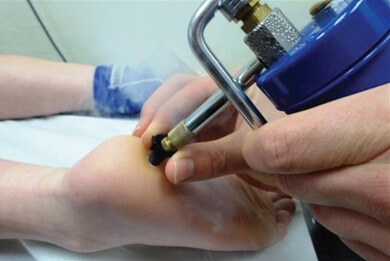
- Cryotherapy: A healthcare provider can use a substance such as liquid nitrogen or argon gas to freeze the plantar wart. This process kills the infected tissue and stimulates the immune system to fight off the virus. Multiple sessions may be required.
- Prescription Medications: Stronger salicylic acid treatments or antiviral creams may be prescribed for stubborn verrucas.
- Laser Therapy: Pulsed-dye or carbon dioxide lasers can target and destroy the blood vessels feeding the wart, causing it to wither
away. - Immune Therapy: Injections of antigens or topical immunotherapy e.g. Diphencyrone (DCP), can help stimulate the immune system to attack the virus.
- Surgical Removal: In cases where warts are painful, large, or resistant to other treatments, surgical excision may be necessary. Your healthcare provider will numb the area with local anaesthetic, cut around the verruca with a scalpel and the remove the wart.
Recovery
The time it takes to recover from plantar warts on feet depends on the chosen treatment and the severity of the wart.
- Home Remedies: can take weeks or months to fully remove the wart. Consistency is key for success.
- Cryotherapy and Laser Therapy: may resolve the problem faster, but often require multiple sessions and may leave the skin tender for a few days afterward. Healing typically takes 2–3 weeks per session.
- Surgical Removal: Recovery may take a few weeks, and care must be taken to prevent infection.
Regardless of the treatment, preventing recurrence of plantar warts on feet is crucial, so you want to:
- Keep the area clean and dry.
- Wear protective footwear in communal areas such as flip flops or verruca socks, and don’t share personal items such as towels, socks or flannels
- Avoiding touching or picking at the verruca to prevent spreading the virus to other parts of the body. Always wash your hands with soap and warm water after touching a wart.
If it is painful to stand or walk, you can use wart pads to cushion the area and reduce the friction on the plantar wart
Frequently Asked Questions About Verrucas
Are Plantar Warts Contagious?
Are Plantar Warts Contagious?
Yes, plantar warts are highly contagious. They spread through direct contact with the HPV virus, often in communal areas like pools, showers, or gyms. The virus can also spread by touching an infected wart and then another part of your body, or someone else’s. Sharing items such as towels, socks and shoes is another easy way to spread the infection.
Can Plantar Warts Be Painful?
Can Plantar Warts Be Painful?
Yes, plantar warts can be painful, especially when located on weight-bearing areas like the heel or ball of the foot. The pressure from standing or walking can press the wart inward, causing discomfort and plantar wart pain
How Deep Are Plantar Warts?
How Deep Are Plantar Warts?
Verrucas can penetrate deep into the dermis, the second layer of skin, due to the pressure of walking. Think of them like a mini iceberg. This is why they may feel deep and painful, but they do not penetrate into the foot bones. You can remove the outer layer of a plantar wart with a pumice stone, but the seed will penetrate deep into the sole of your foot.
Are There Different Types Of Plantar Warts?
Are There Different Types Of Plantar Warts?
Yes, there are different types of plantar warts:
- Solitary Warts: Single warts that may enlarge over time.
- Mosaic Warts: Clusters of smaller warts that grow close together and may merge into a larger area.
The HPV-1 virus causes deep and painful plantar warts, known as myrmecia, whereas the HPV-2 virus causes more superficial, painless warts, known as verruca vulgaris.
Can You Pull Out A Plantar Wart Root?
Can You Pull Out A Plantar Wart Root?
Plantar warts don’t have true “roots.” The black dots seen are clotted blood vessels. Attempting to “pull out” a wart can cause pain and infection. Instead, use treatments like salicylic acid, cryotherapy, or consult a healthcare provider for safe removal.
What Are The Plantar Wart Stages Of Healing?
What Are The Plantar Wart Stages Of Healing?
Healing stages with plantar warts include:
- Softening of the verruca with treatment
- Gradual peeling or shrinking of the wart tissue
- Development of healthy skin underneath as the wart clears
Persistent treatment and patience are key.
Do Plantar Warts Go Away On Their Own?
Do Plantar Warts Go Away On Their Own?
Many plantar warts resolve on their own within 1–2 years as the immune system fights off the virus. However, some require treatment, especially if they’re painful or spreading. They may reappear at a later date, either in the same place or in a different part of the foot.
What Medications For Plantar Warts Are Most Effective?
What Medications For Plantar Warts Are Most Effective?
Salicylic acid and cryotherapy are widely used and effective. For stubborn warts, prescription treatments like stronger acids, immunotherapy, or antiviral medications may be needed. Consulting a healthcare provider can help determine the best option.
Does Having The HPV Vaccine Stop You Getting Verrucas?
Does Having The HPV Vaccine Stop You Getting Verrucas?
No, the HPV vaccine does not stop you getting plantar warts or speed up their healing. There are over 100 different types of HPV and the vaccine doesn’t target the ones that most commonly infect the skin.
Plantar Warts Vs. Corns – What’s The Difference?
Plantar Warts Vs. Corns – What’s The Difference?
Plantar Wart Pain Summary
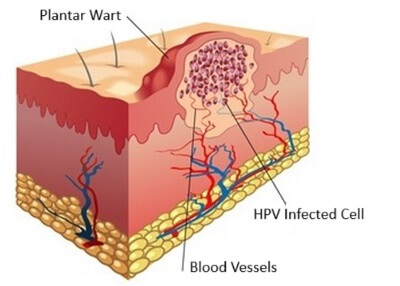
Plantar warts, or verrucas, are a common and often frustrating foot condition caused by the HPV virus.
While they can be painful and disruptive, a variety of effective treatments are available to remove them.
With numerous treatment options available, ranging from at-home remedies to professional interventions like cryotherapy or laser therapy, most plantar warts can be effectively managed and eliminated.
Early intervention can help prevent their spread and minimize discomfort. By taking simple precautions, such as wearing shoes in communal spaces and maintaining good foot hygiene, you can reduce the risk of developing plantar warts and keep your feet healthy and pain-free.
Plantar warts are just one possible cause of pain on the bottom of the foot and foot lumps.
You may also be interested in the following articles
Related Articles
Page Last Updated: 20th November, 2024
Next Review Due: 20th November, 2026
